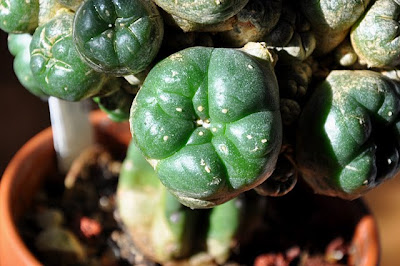I'm sad to say that I have neglected this plant in more than one respect. First I forgot to post on its 5th “grafting anniversary” (this post is almost 5 months due), secondly I didn't check up on it all summer even though it had recently been under attack by red spider mites.

Lophophora williamsii v. caespitosa grafted on Trichocereus stock
As is evident from the pictures I didn't manage to get the mites fully under control before leaving the plant unattended for most of the hot summer months, during which the mites prospered and had a feast on the poor cactus.

Severe spider mite damage
I'm controlling the mites using neem oil, soap, and regular showers – I have considered miticides but am convinced that Darwinistic selection forces will kick in, leaving me with a population of miticide resistant spider mites in the windowsill ;-) I read somewhere that sulfur mixed in with the topsoil repels mites so I might try that (the less aesthetically pleasing solution is to dust the plants with sulfur). Hydrogen peroxide is also said to kill off mites so I still have a couple of options to try out before opting for the harsher chemicals.

Relatively undamaged button
Large areas of the grafted Lophophora williamsii v. caespitosa are still relatively unaffected by the mites so I'm sure it will grow back given time. I'm a bit puzzled, though, why this particular plant is so popular with the mites compared to most other plants in my collection.

Top view of grafted Lophophora williamsii v. caespitosa
For comparison you can check the posts on the same plant one, two, three, and four years ago.
Malpighia 1927 v.30 (added: 11/24/2025)
-
*By:*
Borzi, Antonino,1852-1921.
Penzig, O.1856-1929.
Pirotta, Romualdo,1853-1936.
*Publication Info:*
Messina : g. Capra & co., 1887-89 ; Genova : Tip. di A...
2 weeks ago



















I've had a bad RSM attack this summer too, and the same thing happened: some plants were badly scarred while the ones sitting hext to these seemed unaffected. I can't see a reason for this but for this plant of yours, maybe the fact that it is grafted (a lot more juice for mites to suck) and is such a marvellous cluster (lots of places for mites to hide in) played a part.
ReplyDeleteYes the plant sure has lots of corners and crevices for the little buggers to hide in ;-) I speculated if alkaloid content could possibly play a role, i.e. if increased alkaloid content would deter mites while plants with lower alkaloid levels (like "pumped-up", grafted plants) would be more susceptible to mite attacks? Just a thought though.
ReplyDeleteLophopora,
ReplyDeleteI have posted a few comments recently. The main reason for this post is to maybe start a discussion on anyone whom has used beneficial insects to get rid of mites? Has anyone out there experimented with this? I have found that alot of hydroponic gardeners are using things like ladybugs and other bugs called spidermite destroyers!
This could be an interesting topic..
I once released predatory mites among my plants in an attempt to control the spider mites biologically. My success was rather limited though, as the predators seemed to disperse pretty quickly after being released. I don't know if my spider mite "population" was too small to sustain a healthy population of predatory mites or if the environment just wasn't becoming to them. That being said, I know that the local botanical garden is controlling their pests almost exclusively with predator mites, insects, and nematodes, so I agree this is an interesting subject and I would also like to hear more about others' experience with this.
ReplyDelete